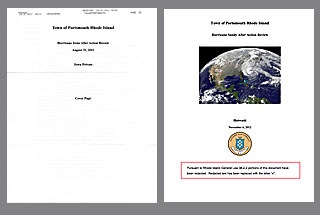Portsmouth reports on Irene and Sandy reveal strengths and (some) gaps

|
| Portsmouth's "after-action" reports from Irene (l) and Sandy (r) . |
Over the weekend, the town of Portsmouth posted to the town web site a promised "after action" report on all departments' response to Hurricane Sandy. Coupled with a similar report for Hurricane Irene which was obtained by harddeadlines through an Access to Public Records Act request, the documents show a significant improvement in the Town's response to this year's event, at least based on their internal assessment.
Most notable, perhaps, were the improved capabilities and performance of the Portsmouth Emergency Operations Center (EOC itself. During a major storm, the EOC serves as the command center to coordinate Town response. During Irene, the report details serious issues, including communications failures (800mHz, RI Emergency Management Agency (RIEMA), and telephone) which left them dependent on ham radio for some links. Other problems included insufficient staffing and basic infrastructure problems like the lights not being wired to emergency power.
The EOC list for Sandy is less threatening: a printer failed, there was a "trip hazard" from an extension cord, and the Internet Public Information (IPI) volunteers were unable to access Skype.
The IPI team was one of the new initiatives created to address feedback from Irene, according to Portsmouth Emergency Management Agency (EMA) Director John King in the November 9 edition of the weekly half-hour cable access show Portsmouth This Week. As IPI team leader Rich Talipsky explained during that same show, one challenge was that the team needed more volunteers to provide 24x7 coverage for the duration of the storm. (Interested Portsmouth residents can find out more on the Portsmouth Emergency Preparedness web site.)
That's not to say that everything was perfect this time. Among the issues identified in the Sandy review are overloaded dispatch lines at Police department, the need for better pet sheltering information for the public, and insufficient staffing at the Department of Public Works. The Portsmouth School District came in for criticism for delaying their decision to close the schools.
But compared to the list of issues identified during Irene, those seem to be more manageable. Consider that, according to the Irene report, there was a generator issue at the Lawton reservoir and that we "came within 24 hours of a no-water situation," or that there were multiple communication failures at the EOC, or that the report admits, in a classic bit of bureaucratese understatement: "media notifications insufficient."
It's worth noting that Portsmouth voluntarily produced the Sandy report and posted it to their web site while the Hurricane Irene report had to be pried out of the Town.
I received the Irene report from the Town Solicitor a week ago, but held publication until the town released the Sandy report, since I think it's in the best interests of the community to read them side by side.
Having been in some of the meetings where access to the Irene report was denied because it contained "operational information," my estimate is that we owe our new Town Administrator John Klimm thanks for pushing the new policy of transparency. I'd encourage fellow citizens to take a look at both reports and also submit your feedback to the town through their online survey.
Full disclosure: I was a member of the IPI and resigned in protest on Friday, October 26 when Portsmouth EMA had yet to post any information about the impending storm. While I am encouraged by the response to Sandy, I continue to withhold judgement on whether the lessons about the appropriate role of advance communication have been baked in to policies and procedures.
And, of course, while I understand that that the Town needs to balance security and privacy against the public's right to know, and while I respect RIGL 38-2-2, as a journalist and citizen, I never like to see redactions.